“Ducati Land”. That was the tag Marc Marquez labelled the Red Bull Ring on Saturday, despite setting pole position in Q2 by 0.002 seconds over Andrea Dovizioso. There was no debate about his statement, the slow corners, followed by long straights that the Red Bull Ring is comprised of suits the Desmosedici perfectly.
In the same moment, the same characteristics of the Red Bull Ring lend themselves extremely well to Jorge Lorenzo, whose style is all geared to strong corner exit speed.
Whilst there was a miscommunication on Saturday in the #99 side of the Ducati garage, it would be solely down to his only two rivals – Marquez and Ducati teammate Andresa Dovizioso – to defeat the Majorcan over the 28-lap race distance.
But that is not to say that Lorenzo was the clear favourite; both Marquez and Dovizioso had looked at least as strong as the five times World Champion on the previous two days, and Marquez was the only rider in the field to have managed to get a long run in on all tyres.
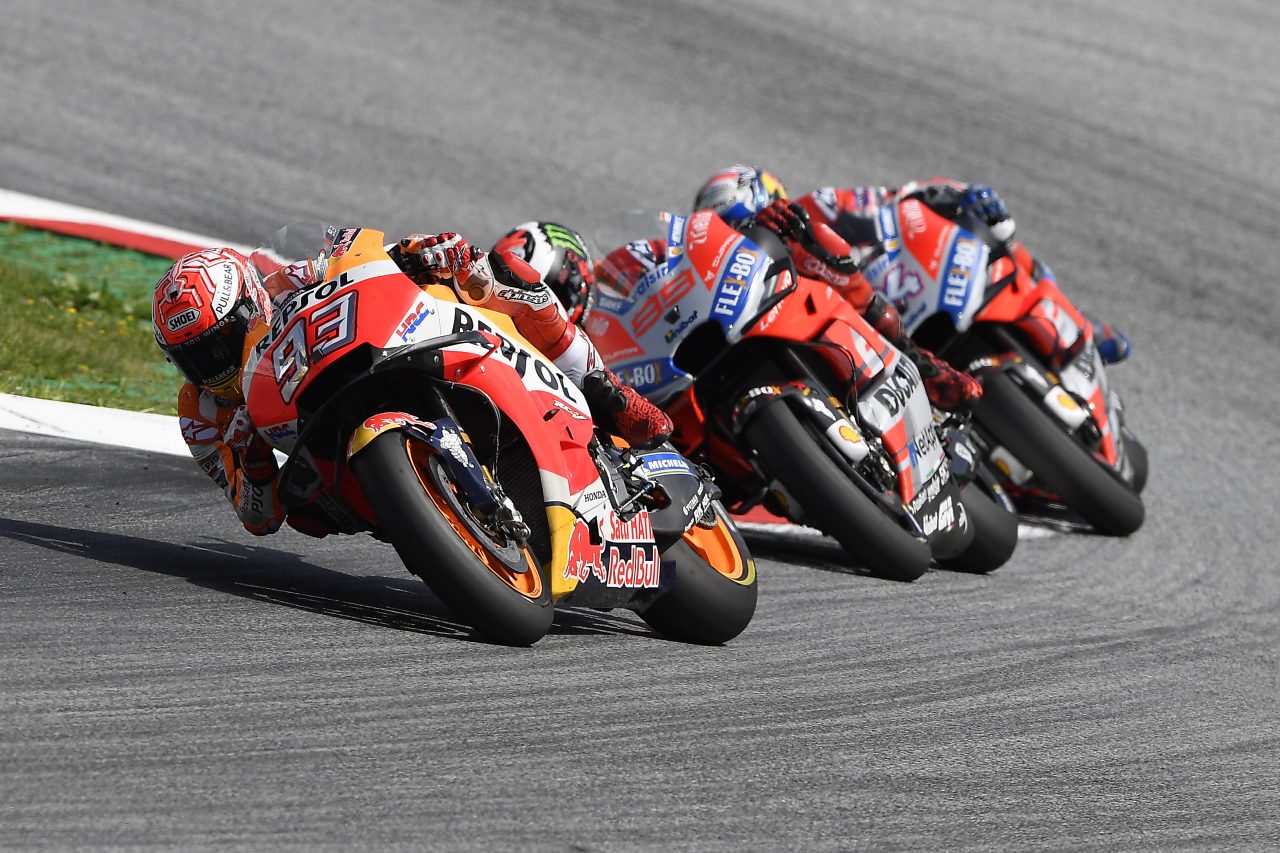
However, it made it no less surprising to see Marquez escape at the front in the beginning of the race. The reigning World Champion admitted after the race that his strategy was to bolt away at the start, to try to fight only one Ducati, as he had learned from Brno that fighting two factory Desmosedicis at the same time is nearly impossible, such is their strength in both acceleration and braking.
His strategy nearly worked. When Marquez passed Dovi in turn three on the first lap, he ran the Italian out wide, costing him two places. It let Lorenzo through, but Marquez at this stage was more worried about Dovi. Once Marquez had passed Lorenzo for the lead, he started to pull away, and Lorenzo looked to be both struggling and holding up his factory Ducati teammate.
But Dovizioso was unable to pass the number 99, which for a while looked okay, because the gap between Marquez and Lorenzo was decreasing. But in the same moment as Lorenzo passed Marquez for the lead, in turn one on lap nineteen, Dovizioso ran wide, lost one second, and was unable in the remaining ten laps to close the margin.
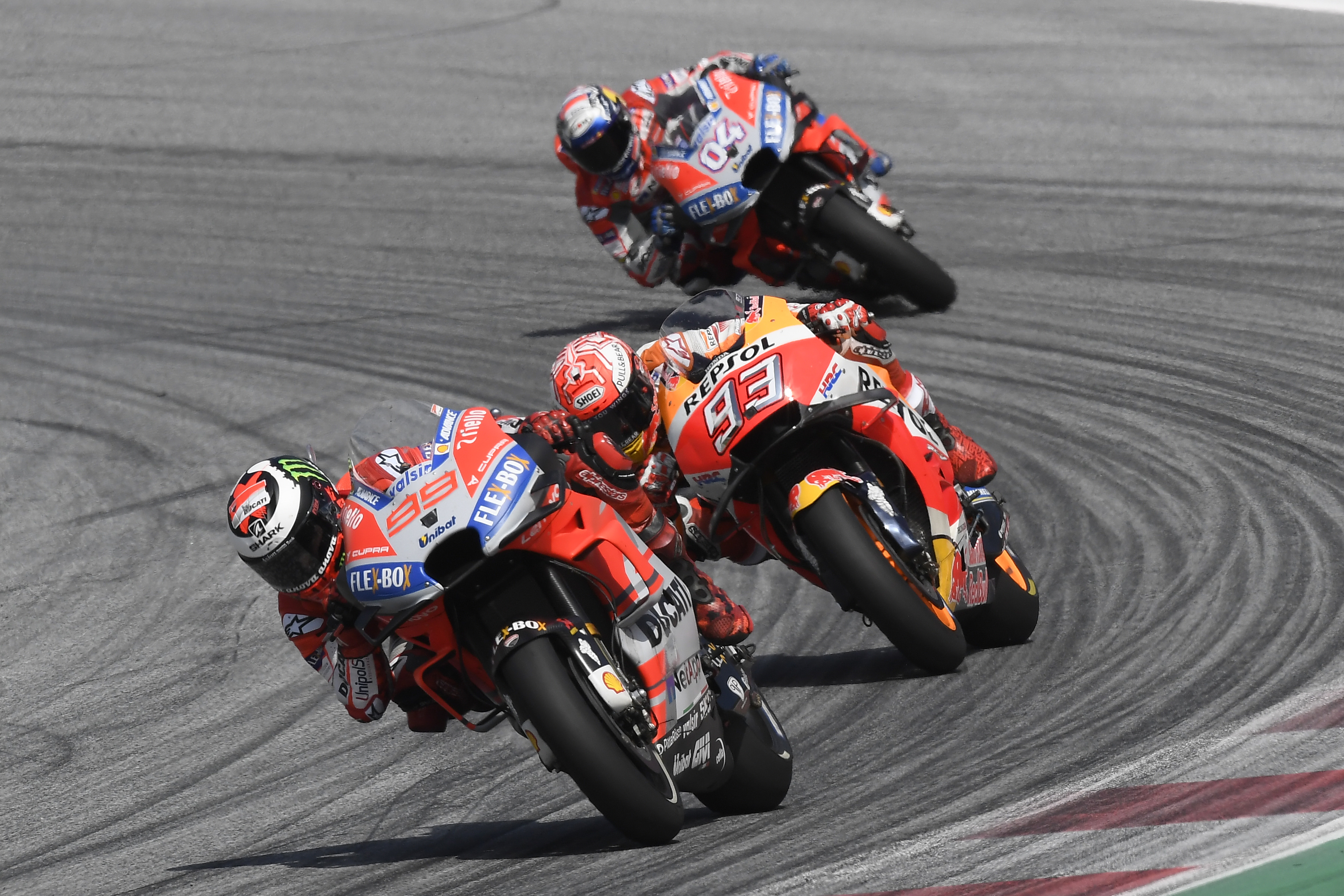
It was, then, between Lorenzo and Marquez. They swapped positions often, Marquez being very strong into turn three, and Lorenzo more so in turns one, eight and nine.
Eventually, the final lap arrived, with Marquez leading into it, but Lorenzo passing him into turn one. Marquez responded in turn three, but simultaneously lost both the front and the rear, which meant Lorenzo was able to carry the momentum around the outside, and out-drag the number 93 to turn four. The gap now was quite big, and over Lorenzo Marquez did not have the same advantage in the two left handers of turns six and seven that he had over Dovizioso last year. This, combined with Marquez’s mistake in turn three, was the deciding factor, because Marquez could not get close enough into either turn nine or ten to make a pass, and he could not deny Lorenzo victory.
Jorge learned his lesson from last year. In 2017, he went too hard at the start, trying to escape, but he used too much fuel, which meant that he had to run softer engine modes in the later laps, giving him nothing to fight with in the second half of the race. This year, he managed the fuel at the start, as well as the tyre (he went soft-soft), and this allowed him to attack more at the end, at no disadvantage to Marquez. Furthermore, Lorenzo proved once again that the soft, when managed correctly, can last better than a medium or a hard rear tyre, simply because it spins less, and so there is less excessive temperature build up in the tyre.
Perhaps, though, the most impressive thing about Lorenzo’s ride, was his aggression in the battle against Marquez. There were some tough moves going down in this battle, it was a proper scrap, one that you might expect Lorenzo to lose out in, in the past, but on this occasion, just like in Brno a week previous, Jorge had enough and more to be able to put up a fight against the best scrapper in the world, and he turned the Red Bull Ring from “Ducati Land” to “Lorenzo’s Land”. Again, we ask “what if?” What if Jorge Lorenzo had started the season in the form he has had since Mugello. What if Ducati had listened to him, and given him the fuel tank modifications sooner? What if Ducati re-signed him? Jorge Lorenzo has the potential to fight for this world title, but unfortunately all the work he has put in this year to work out the Ducati will be for nothing when he jumps on the Honda RC213V at Valencia in November, and starts all over again. But for now, he and the Desmosedici might just be the strongest package out there.
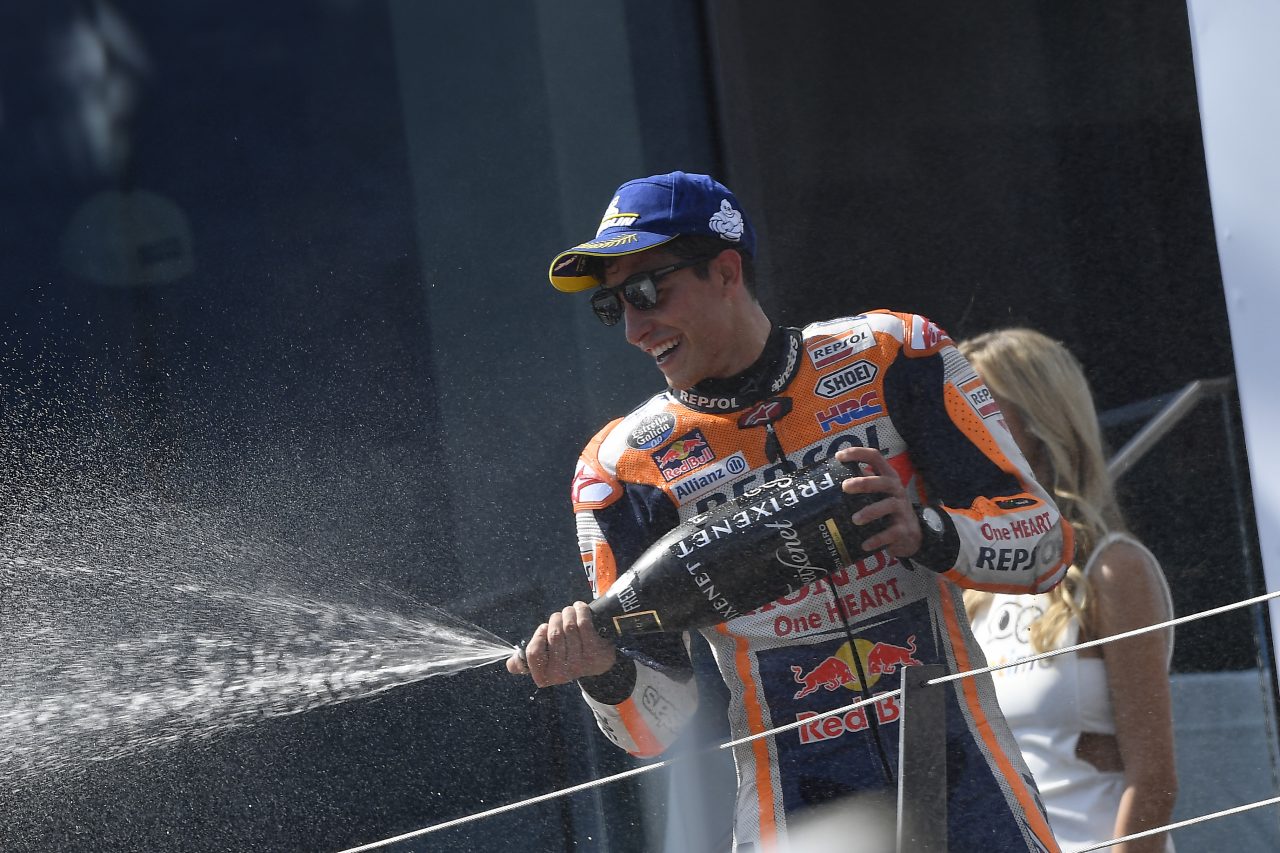
For Marquez, it was yet another disappointing defeat at the hand of a Ducati rider in the final lap. That said, he couldn’t do much about it. The Ducati gets out of the corner better than the Honda, it has more power in the straight than the Honda and it has better braking stability than the Honda. You can’t fight that. Marquez was over the limit trying to fight the Ducati of Lorenzo in this battle, and when that happens he normally wins. In fact, against any other bike, he wins 9/10 times. Even still, Marquez can be content with his effort in Austria, he beat one Ducati in their best track, and he extended his championship lead to 59 points. The title is still his to lose, and ultimately he knows that in the long run – pas this year – Dovizioso is probably his main threat over the course of the season, and Marc demolished Dovi this weekend.
Dovizioso’s problems started before the race, in the tyre selection. He chose medium tyres front and rear, compared to his teammate’s all-soft choice. From the beginning of the race, Dovizioso was struggling to get the bike to stop , and the time he spent behind Lorenzo killed his race, because that was when he was the most comfortable. The mistake he made ten laps from the flag cost him one second, and after that for a couple of laps he couldn’t find a rhythm. By the time he found his pace again, his tyre was finished and the leaders were gone. A disappointing race for Dovi, but another podium strengthens his bid for second in the championship, and you would probably still expect the Italian to be more consistent for the rest of the season than Lorenzo, although Lorenzo now leads him in the championship by two points.
Fourth over the line was Cal Crutchlow, nine seconds back from the win, and 3.5 seconds clear of Danilo Petrucci in fifth. The critical thing for this pair, for the race, was the personnel. Both of them have factory bikes, but none have factory teams, and this is what makes the difference in a rear-tyre-limited/fuel-limited race like this one, because the factory riders have a lot more people working to find the perfect electronics setting, and the perfect fuel strategy. Still, it was Crutchlow’s best Austrian performance by far, after a ride-through in 2016, and a fifteenth last year. Ahead of Silverstone in two weeks, this is a great way for the Brit to go into it, as he looks to win his home race for the first time in his career.
Valentino Rossi and his team made a change in warm up on Sunday morning which allowed him to be more consistent with a used tyre. With this gain, he was able to half-rescue Yamaha’s weekend by finishing sixth, which was beyond his expectation. Of course, it was still a disastrous weekend for Yamaha, and Rossi is still without a podium in Austria in the top class, but the gains made in warm up they will hope can transfer to Silverstone, where they were strong last year.
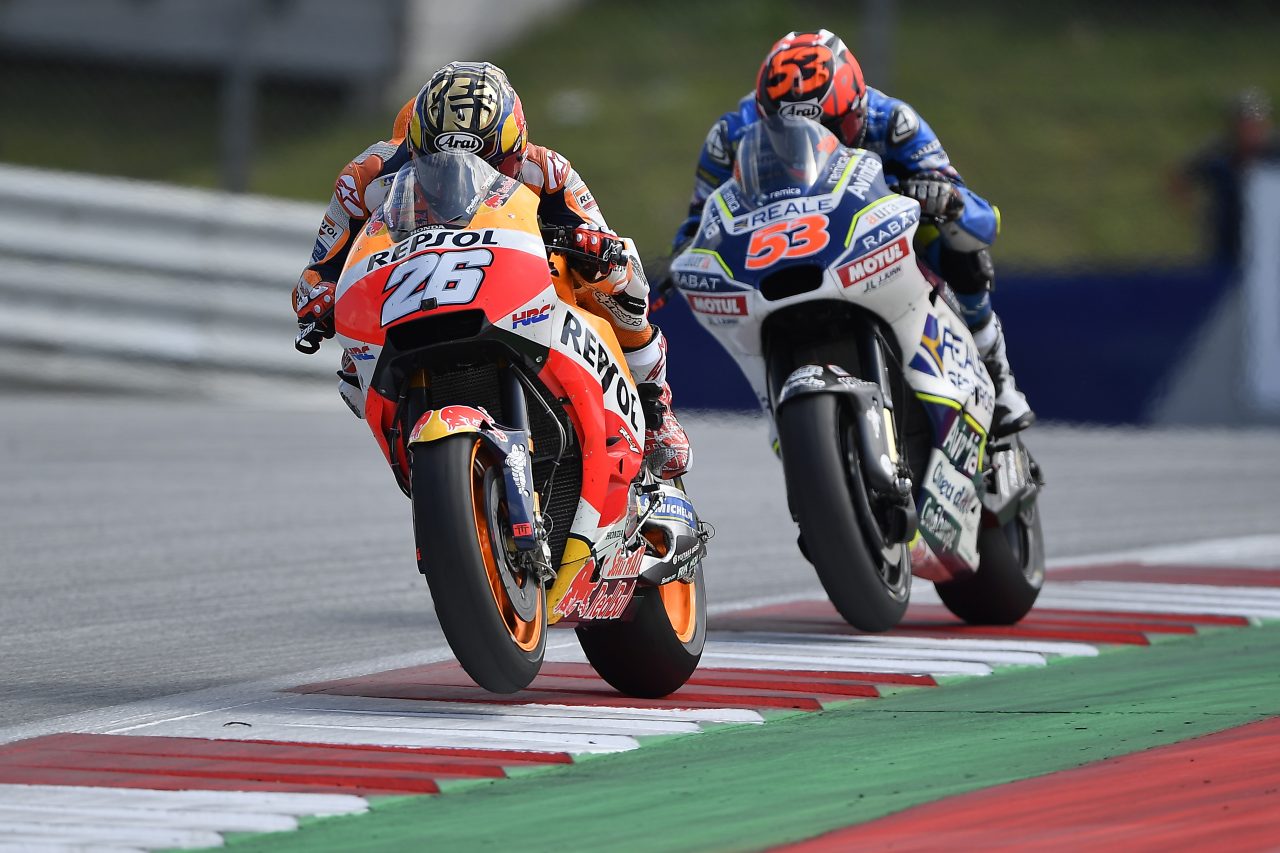
Dani Pedrosa took seventh place. He got beaten up quite badly in the beginning of the race, in those first two hard braking zones at turns one and three. From there he pretty much followed Rossi through the pack to seventh, helped by some strong late race pace. The critical thing for Dani is a similar one to that of Maverick Vinales, being able to go fast in the beginning. There are circuits coming up which have the potential to be front tyre races, and if Dani can find what he needs, he may yet be able to make his whole MotoGP career winning one race in each season.
Eighth place went to Alex Rins. He was running sixth for much of the race, but was caught by Rossi and Pedrosa quite quickly at the end, indicating he ran out of medium rear tyre. It seems Rins ran into the same tyre wear issues that Suzuki teammate Iannone encountered throughout the year.
Johann Zarco showed what happens when you choose the soft tyre, but can’t manage it, as he came home down in ninth, despite a decent start from the Frenchman from sixth on the grid.
Alvaro Bautista managed to recover a top ten spot despite a difficult start where, like Pedrosa, he was beaten up in those initial stages. Alvaro continues to advertise himself fairly well, as he looks to seal himself a factory Ducati deal for the 2019 Superbike World Championship.
Avintia Ducati’s Tito Rabat looked to be having a strong race, running well inside the top ten for much of the 28 laps, but suffered a one-second-per-lap drop off with his soft rear tyre in the final five laps, in which he dropped from ninth to eleventh behind both Zarco and Bautista. Still, it was a strong weekend for Rabat, who seemingly didn’t need much on the electronic side to save his top ten spot.
The Austrian GP weekend was one to forget for Maverick Vinales. After his poor qualifying on Saturday – not helped by sensor issues – he could only manage twelfth place in the race. He made his typical poor start, dropping to 16th in the first lap, but didn’t have his usual late race pace. This weekend, Vinales complained that it felt like his bike had no power in the opening stages of the race. It’s hard to justify, from the outside, why that would be the case, but anyway, Vinales will be looking to the private test for Yamaha in Misano before Silverstone as an opportunity to make some progress on the bike, but you have to wonder how much he believes he can actually find anything positive at all.
An off-track excursion in the middle of the race cost Andrea Iannone badly. After that, he set four laps which were some of the fastest of the race, but he couldn’t follow it up. The questions are being asked of Iannone again – since he signed for Aprilia for the 2019 and 2020 seasons, his form has completely disappeared. This performance didn’t do much to help this situation.
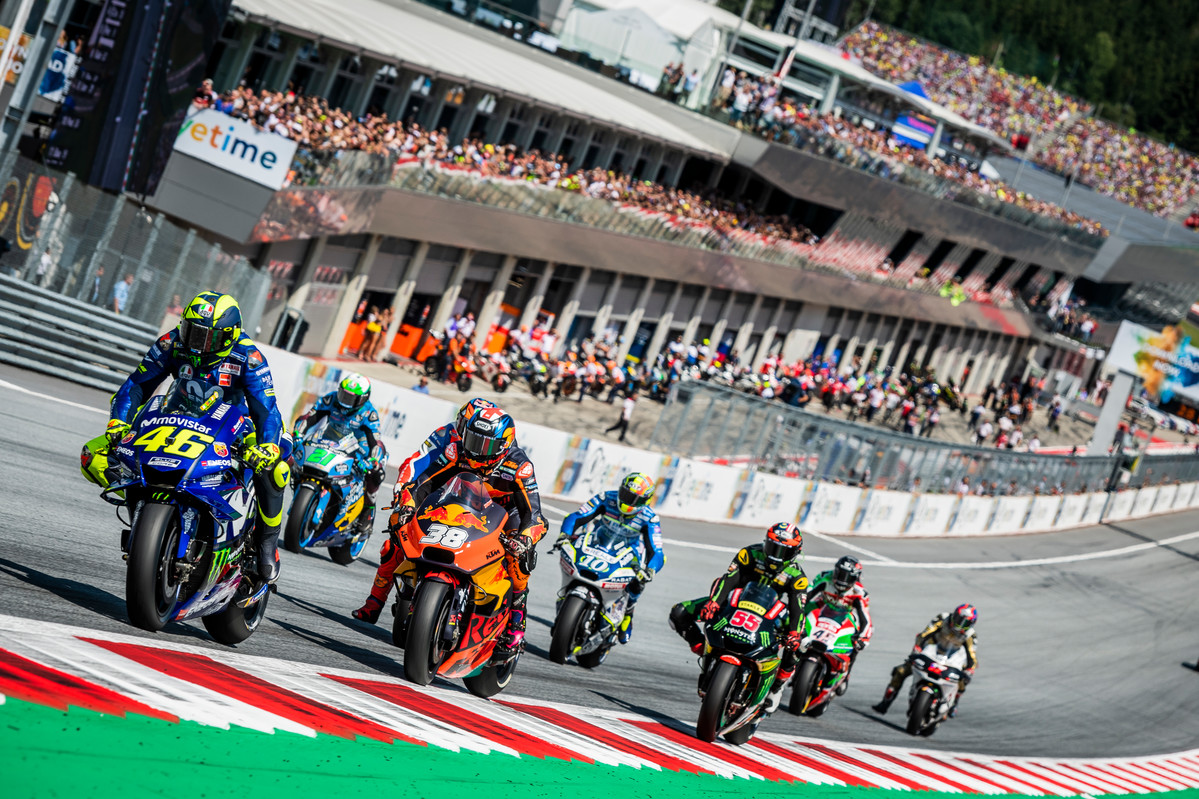
A stunning start put Bradley Smith up into the top ten at the start, but by the end of the race the British rider had dropped back to 14th. Nonetheless, a good weekend at home for KTM, picking up some more valuable World Championship points.
The final point went to Takaaki Nakagami, who was the top rookie in fifteenth, 0.9 seconds clear of Hafizh Syahrin.
Aleix Espargaro could only manage seventeenth place on the Aprilia, just ahead of a struggling Jack Miller; then Franco Morbidelli was nineteenth whilst a somewhat disgruntled Scott Redding rounded out the top twenty, a performance and result which left him very open about his opinion on the workings of the team, and also the bike.
Karel Abraham came home in twenty-first place, whilst Tom Luthi was the final finisher in 22nd.
Xavier Simeon had enjoyed his best weekend in MotoGP until lap nine of the race, when he became the only crasher of the race.

